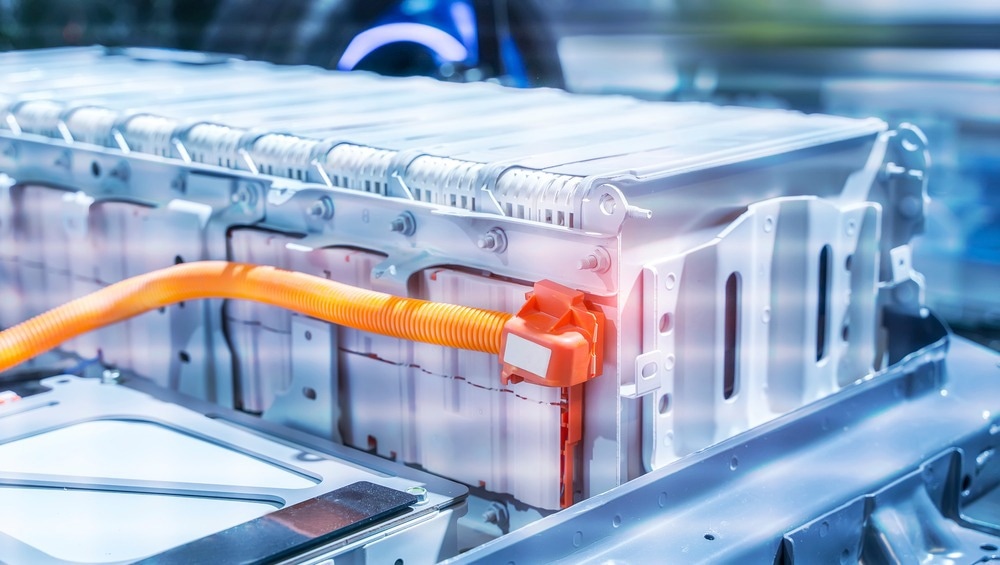Researchers created a new and safer electrolyte for lithium-ion batteries that performs just as well in subzero temperatures as it does at room temperature.

Image Credit: asharkyu/Shutterstock.com
Many electric vehicle owners are concerned about how efficient their batteries will be in cold weather. New battery chemistry might resolve that issue.
The fundamental issue with today’s lithium-ion batteries is the liquid electrolyte. This important battery component transports charge-carrying particles known as ions between the battery’s two electrodes, allowing the battery to charge and discharge. However, at subzero temperatures, the liquid begins to freeze. In cold regions and seasons, this circumstance substantially affects the effectiveness of charging electric vehicles.
To overcome this issue, scientists from the Department of Energy’s (DOE) Argonne and Lawrence Berkeley national laboratories created a fluorine-containing electrolyte that functions well even at sub-zero temperatures.
Our research thus demonstrated how to tailor the atomic structure of electrolyte solvents to design new electrolytes for sub-zero temperatures. Our team not only found an antifreeze electrolyte whose charging performance does not decline at –4 ºF, but we also discovered, at the atomic level, what makes it so effective.
Zhengcheng John Zhang, Senior Chemist and Group Leader, Chemical Sciences and Engineering Division, Argonne National Laboratory
This low-temperature electrolyte shows great promise for use in electric vehicle batteries as well as energy storage for electric grids and consumer electronics such as computers and phones.
The electrolyte of today's lithium-ion batteries is a mixture of a widely available salt (lithium hexafluorophosphate) and carbonate solvents like ethylene carbonate. The solvents dissolve the salt, resulting in a liquid.
When a battery is charged, the liquid electrolyte transports lithium ions from the cathode (a lithium-containing oxide) to the anode (graphite). These ions migrate out of the cathode and then via the electrolyte into the anode. They travel through the electrolyte at the core of clusters of four or five solvent molecules.
During the first few charges, these clusters interact with the anode surface, forming a protective layer known as the solid-electrolyte interphase. This layer, once generated, functions as a filter.
Only lithium ions can flow through the barrier, whereas solvent molecules are blocked. As a result, the anode may store lithium atoms in the graphite structure on charge. Electrochemical reactions liberate electrons from the lithium during discharge, generating electricity that can power vehicles.
The problem is that the electrolyte with carbonate solvents starts to freeze in cold temperatures. As a result, it loses its capacity to charge lithium ions into the anode. This is because the lithium ions are closely linked within the solvent clusters.
As a result, these ions require significantly more energy than ambient temperature to empty their clusters and breach the interface layer. As a result, scientists have been looking for a better solvent.
The researchers looked into different fluorine-containing solvents. They were able to determine which composition had the lowest energy barrier for releasing lithium ions from clusters at subzero temperatures. They also discovered why that particular mixture worked so well at the atomic scale. It was determined by the position and number of fluorine atoms within each solvent molecule.
In laboratory cell tests, the group’s fluorinated electrolyte maintained stable energy storage capacity for 400 charge–discharge cycles at –4 ºF. Even at that subzero temperature, the capacity was equal to that of a room-temperature cell with a standard carbonate-based electrolyte.
Our research thus demonstrated how to tailor the atomic structure of electrolyte solvents to design new electrolytes for sub-zero temperatures.
Zhengcheng John Zhang, Senior Chemist and Group Leader, Chemical Sciences and Engineering Division, Argonne National Laboratory
The antifreeze electrolyte has an added benefit. It is much safer than conventional carbonate-based electrolytes since it does not catch fire.
We are patenting our low-temperature and safer electrolyte and are now searching for an industrial partner to adapt it to one of their designs for lithium-ion batteries.
Zhengcheng John Zhang, Senior Chemist and Group Leader, Chemical Sciences and Engineering Division, Argonne National Laboratory
The study was published in the journal Advanced Energy Materials. In addition to John Zhang, Dong-Joo Yoo, Qian Liu, and Minkyu Kim from Argonne contributed to the study. Berkeley Lab authors are Orion Cohen and Kristin Persson.
DOE Office of Energy Efficiency and Renewable Energy, Vehicle Technologies Office funded the research.
Journal Reference:
Yoo, D., et al. (2023). Rational Design of Fluorinated Electrolytes for Low Temperature Lithium‐Ion Batteries. Advanced Energy Materials. doi.org/10.1002/aenm.202204182.